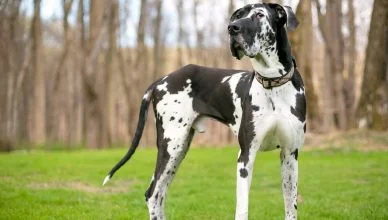If you are looking for a dog that is easy to train, then the Great Dane is not your best choice. The Great Dane needs a lot of patience, time, and effort before they can be trained to do anything. They should be trained from an early age to keep them happy and healthy throughout their lifetime.
This article will focus on Great Dane training tips and methods so that your dog can become an obedient and smart companion.
6 Great Dane Training Tips
Great Dane training can be a daunting task for both the owner and the dog. However, with some simple tips and tricks, it can be easier to train your Great Dane. Here are some tips on how to train your Great Dane as well as some tips on how to care for them properly:
- Start training when they are young – socialize them so they learn the rules and communicate with humans;
- Keep them busy with interactive games such as fetch or tug of war;
- Establish a routine that will let your dog know what comes next- this reduces the likelihood of them getting anxious or acting out.
- Use positive reinforcement – praise and reward your dog when they do something good, instead of punishing bad behavior.
- Change The Duration of Training Sessions depending upon the age and maturity of your dog.
- Appreciate your dog’s efforts. Being appreciative will surely motivate your Great Dane to perform better.
How to Train a Great Dane with 5 Effective Training Methods
With a variety of training methods, Great Danes can learn to be trained more effectively and quickly. Some of the training methods are:
1. Socialization
Socialization is the process of introducing a new puppy into an existing group of interacting individuals in order for them to become more comfortable around each other. It helps build a positive relationship between the new pup and the group members.
When it comes to Great Danes, proper socialization is key to building their social skills. A young age of 8 weeks is generally recommended for socializing a Great Dane and not later than 1 year old. Early days are a great time to build your Great Dane’s social skills. Exposing your dog to many different people and situations will help them get accustomed to social life.
2. Obedience training
Giving your Great Dane obedience training is not just about teaching them commands, but it also involves teaching them how to behave in public places such as restaurants or offices. It also teaches them boundaries and manners which will keep them safe while staying with other people’s homes or places of work.
3. Crate training
Crate training is a type of confinement, which is used to keep animals safe and secure. It helps in preventing them from escaping or causing harm to themselves or others. Crate training your Great Dane is a great way to prevent your dog from chewing on things, minimizing their wanderlust potential, and staying out of trouble. It is also a great way to keep your dog from barking too much or getting into fights with other dogs. In addition, this method helps in preventing separation anxiety for dogs that are left alone for long periods of time.
4. Clicker Training
Clicker training is a popular method of training dogs, especially for those who are new to dog ownership. It is a type of positive reinforcement training that uses a high-pitched sound to signal the dog’s attention. One way to use clicker training for your dog is to teach them how to play fetch or bring you their favorite toy. This can be done by clicking and treating when they catch the ball or bringing you their toy.
5. Leash training
Leash training is one of the best ways to train a dog. It teaches them how to behave and respect you when they are given a leash. It also teaches them that they need your permission before they can do anything, like going for a walk. When it comes to leash training, there are two main types of leashes: retractable and retractable with handle loop.
Retractable leashes are easier to use and work well for short walks around the block or in your backyard where you don’t have much space or time to exercise your dog’s obedience skills. The latter is recommended because it gives the handler more control over the dog while walking on a leash.
Conclusion
Great Danes are known for their gentle nature and friendly demeanor, but they are also known to be stubborn. They will test your boundaries and push back against any commands they don’t understand or agree with. You will have to put in some time and effort in order to train your pet and make sure that they will behave well around other people and animals.
Thank you for reading the article.
To explore more about the breed, here are other Great Dane-related articles that you might be interested in.
Do you have a Great Dane? How do you train them? We would love to hear from you. Please share with our community by leaving a comment below!
